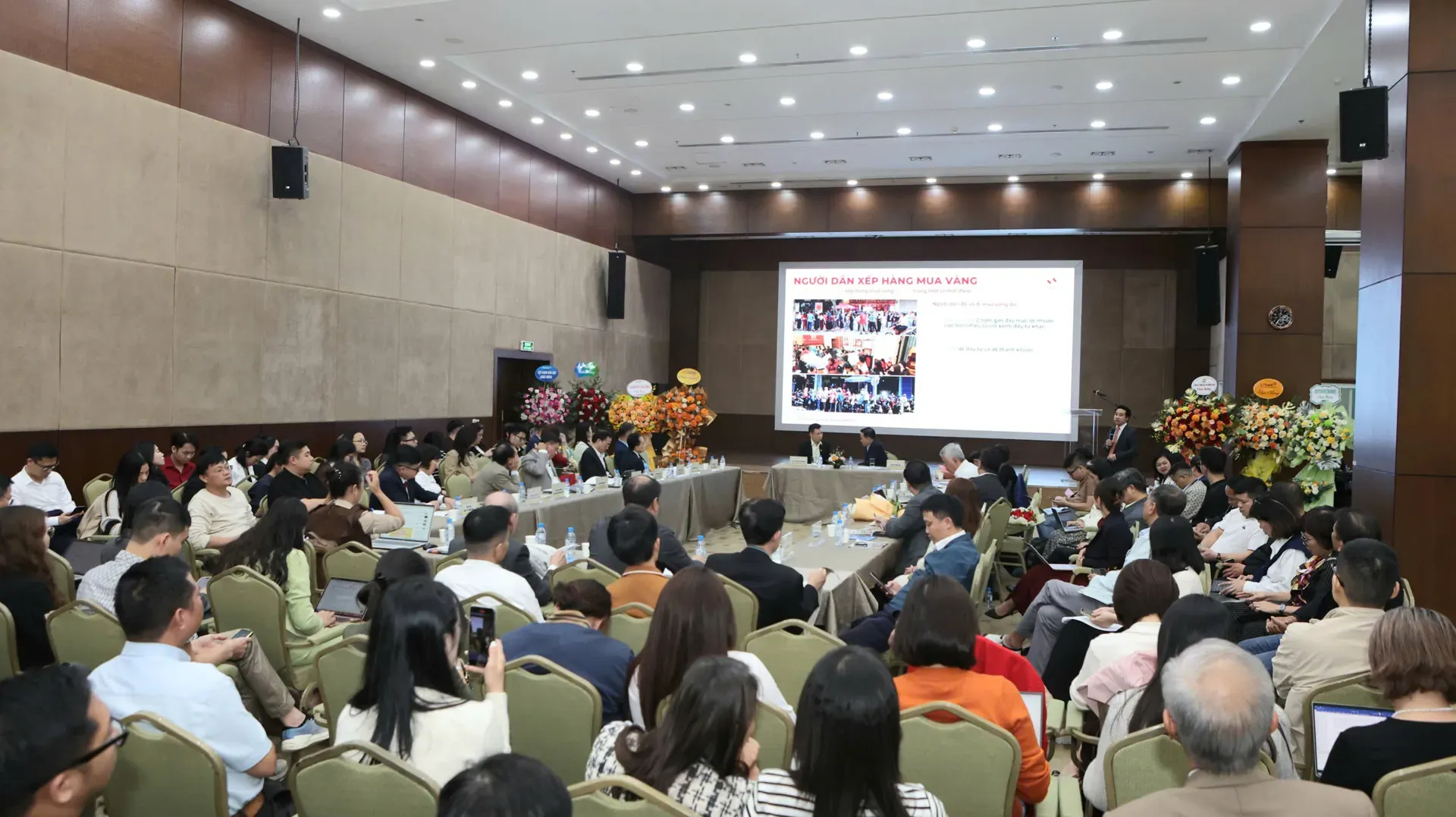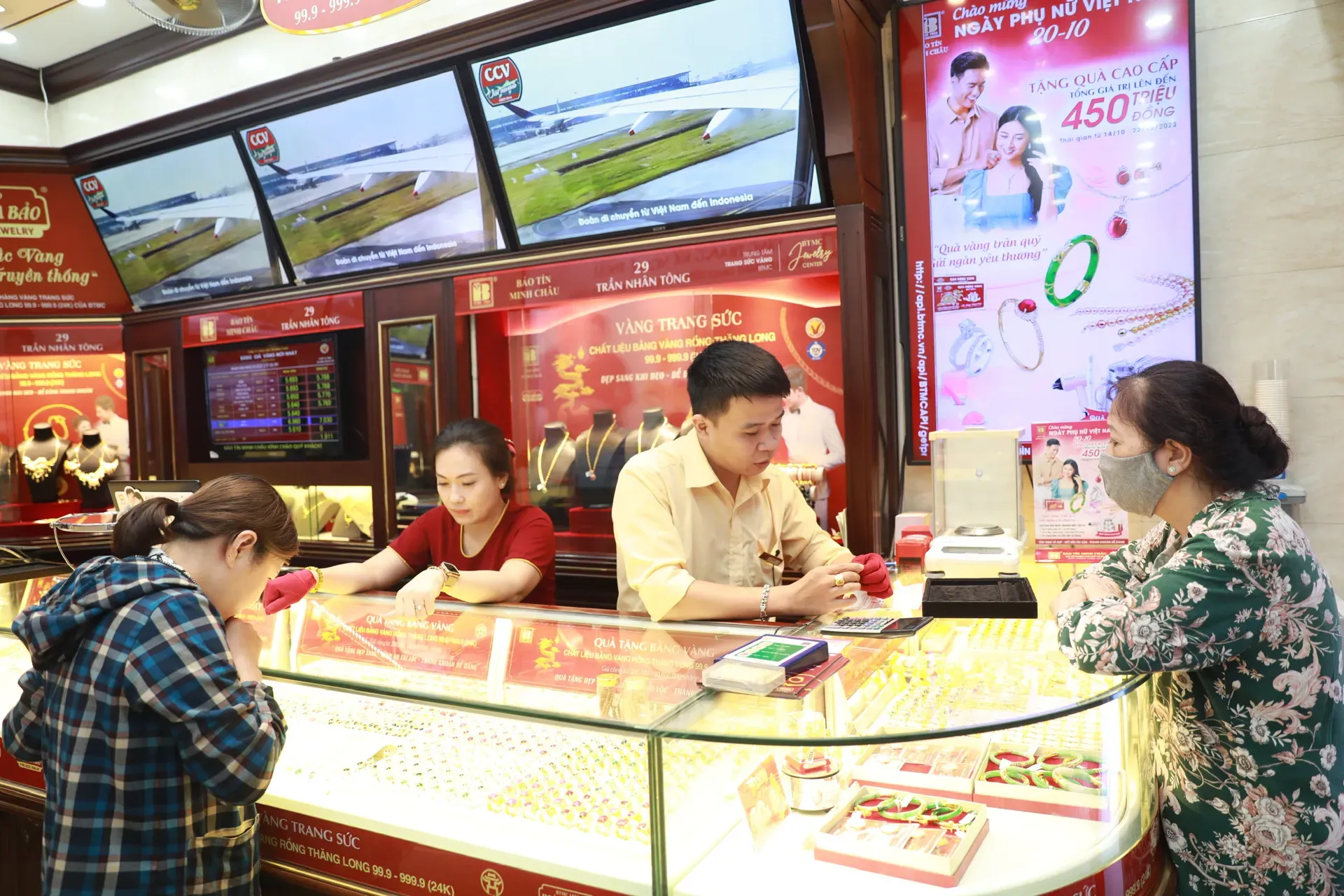Vietnam turns to digital oversight to clean up gold trading and curb speculation
Regulators in Hanoi said on November 24 that technology and digital tools can help curb violations in the gold and jewelry trading and prevent risks to financial stability.
Technology-driven oversight is essential to tighten control over gold and jewelry trading and stabilize the market, market management officials said today (November 24), stressing that digital tools are needed to curb violations and reduce speculation.
Their statement was made at a gold market roundtable hosted by Kinh te & Do thi (Economic & Urban) Newspaper.
Complex market developments
According to Kieu Dinh Canh, Deputy Director of the Hanoi Market Management Department, Vietnam consumes more than 55 tons of gold each year.

Overview of the conference on the Vietnamese gold market. Photo: Thanh Hai/The Hanoi Times
Domestic and global gold prices have sometimes differed by nearly VND20 million ($760) per tael, fueling speculation, pushing retail prices higher and creating pressure on macroeconomic stability.
In 2024, Hanoi’s market management forces detected and handled 107 violations related to gold trading, imposed VND1.36 billion ($51.6 million) in administrative fines and confiscated and destroyed VND163 million ($6,180) worth of violating goods.
Since the start of this year, the Hanoi Market Management Department has recorded one case of unauthorized gold bar trading, fined it VND819 million ($31,050) and confiscated one tael of gold worth VND81 million ($3,070).
Canh said many gold businesses have committed violations such as misrepresenting gold purity, selling gold without proper invoices and taking advantage of price differences to speculate and raise prices, harming consumers and affecting the broader economy.
He added that some individuals and organizations have exploited market volatility and public demand for gold storage to mix counterfeit or low-quality gold and counterfeit-branded products into the market.
“The gold market has become a factor that directly affects national financial and monetary security, so regulatory agencies must respond promptly and strongly,” he said.
Nguyen Tien Minh, Deputy Director of the Hanoi Tax Department, said tax authorities have detected unusual transactions and violations in tax declarations and accounting, requiring stronger tax oversight and transaction transparency.
Hanoi currently has 844 businesses trading gold, jewelry and gemstones. Budget revenue from this sector increased sharply, from more than VND800 billion ($30.3 million) in 2024 to VND1.25 trillion ($47.4 million) from the start of 2025.
In 2024–2025, the Hanoi Tax Department launched electronic invoices generated from cash registers to support businesses and enable real-time data connection with tax authorities.
The department also strengthened coordination with enforcement agencies to cross-check invoice data and detect violations, Minh said.
The tax official noted persistent issues such as incorrect tax calculation, incomplete declaration of gold-related costs and inconsistent accounting practices.
Authorities also discovered many personal accounts receiving unusually large cash flows inconsistent with declared business activity, along with signs of illegal gold trading that have been transferred to investigators, he said.
Gold smuggling and jewelry fraud remain widespread
Nguyen Duc Le, Deputy Head of the Market Management Operations Division under the Ministry of Industry and Trade, said Vietnam’s gold jewelry business network remains fragmented, small-scale and scattered, especially in remote areas.
He said this makes state management difficult and leads to weak governance at many gold businesses and signs of unfair competition.
According to Le, the Ministry of Industry and Trade and relevant agencies have increased inspections of the gold jewelry market, but the lack of data on the number of gold businesses and no requirement for gold quality disclosure has led to many violations.
He said key issues include inconsistent gold purity across products, preventing consumers from comparing similar items; businesses reporting false information on gold origin and quality; and mismatched weights between product labels and actual measurements.

Trading gold at a store on Tran Nhat Tong Street, Hanoi. Photo: Pham Hung/The Hanoi Times
He added that enforcement teams lack unified tools, testing methods and technical knowledge of gold craftsmanship.
“These limitations hinder inspections and affect consumer interests, so inspectors often take action only when complaints arise,” he said.
Dang Van Duc, Deputy Director of the Anti-Smuggling Investigation Department under Vietnam Customs, said gold smuggling remains attractive due to its high value, ease of transport, global liquidity and ability to preserve value during instability such as war or inflation.
Vietnam’s long border of more than 4,000 kilometers but only 157 official border gates and 88 checkpoints creates persistent smuggling risks, he said.
Duc noted that each gold smuggling case often involves large quantities, with typical seizures of around 10 kilograms along land routes.
He said the wide gap between domestic and global gold prices continues to drive attempts to transport gold and currency across borders illegally.
Applying technology to market management
Le from the Ministry of Industry and Trade proposed establishing clear legal frameworks and standards, implementing digital traceability for gold, building risk-monitoring mechanisms and improving testing capacity.
He also recommended transparent information to protect consumers and compensation mechanisms when risks occur.
Le suggested developing a sandbox as a pilot zone for gold jewelry businesses with full traceability.
In this sandbox, gold and jewelry stores will receive public credibility ratings to encourage product innovation and quality improvement, he said.
“This can help build reputable Vietnamese jewelry brands with international potential, enhance product quality and create a healthier gold market,” Le added.
Commenting on tech-based management, the Hanoi Tax Department’s Deputy Director Minh said oversight must rely on electronic invoice data and payment transactions to detect abnormalities and manage gold trading effectively.
He said businesses must record buyers’ ID numbers or tax codes on output invoices. When buying gold from individuals, businesses must prepare detailed information sheets with the seller’s personal data.
The Hanoi Tax Department representative said the national electronic invoice system processes billions of invoices annually, requiring Big Data analysis to identify irregularities.
Minh emphasized that high-value gold transactions should require bank transfers to ensure clear transaction ownership and prevent unclear cash flows.

A gold store in Hanoi. Photo: Hai Linh/The Hanoi Times
He proposed integrating citizens’ gold purchase data with businesses’ input invoices to create a unified platform for detecting smuggling risks.
“Data must be shared across regulatory agencies. This is a key measure to ensure transparency, especially for large-value transactions,” he said.
To ensure transparency and avoid tax losses, regulators must develop a unified legal framework for interagency data sharing, Minh added.
He also urged agencies and businesses to communicate more so people stop buying and selling gold and jewelry products in cash and without invoices, creating opportunities for tax evasion and smuggling.
Regarding tax policy, Minh said the draft amended Personal Income Tax Law proposes new adjustments for gold bar transactions to increase transparency and improve oversight.
Canh from the Hanoi Market Management Department, called on regulators to make laws clearer, more practical and more applicable for businesses.
“Market management forces must improve their professional knowledge and skills to handle violations effectively,” he said. “We must strengthen education and guidance to help businesses comply.”
He said gold businesses must publicly list prices to limit price manipulation, prevent price markups during volatility and reduce speculation.
Regarding anti-smuggling measures, Duc from Vietnam Customs said authorities will tighten control along land and inland water routes in border provinces with Cambodia and Laos.
He said key international airports will also face enhanced checks in the last months of 2025 while customs officials will receive support in X-ray image analysis and intelligence gathering to identify high-risk items for inspection.
Duc urged close coordination among border task forces, including finance, customs, border guards and police.
He added that customs will conduct post-clearance inspections of companies importing gold for processing, export production and bonded operations.
Customs officials said the sustainable solution is to review gold management policies, reduce smuggling incentives, study international gold transaction tax practices and ensure transparency in gold jewelry trading.








